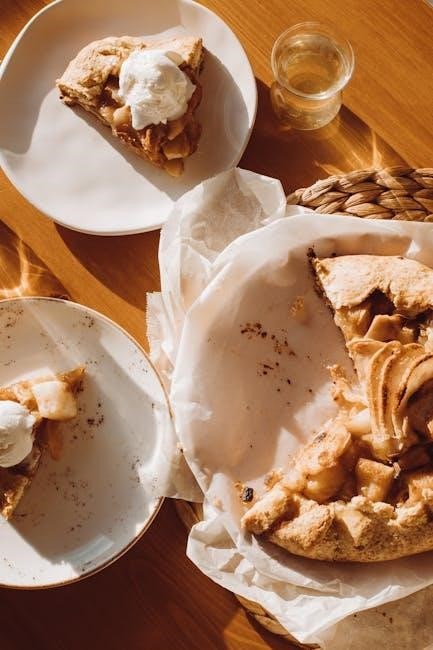Cake pricing is a strategic balance of cost‚ labor‚ and customer demand‚ ensuring profitability while providing value. This guide offers insights and strategies for accurate cake pricing.
Understanding the Basics of Cake Pricing
Cake pricing involves calculating the cost of ingredients‚ labor‚ and overhead while ensuring a reasonable profit margin. It requires balancing affordability for customers with sustainability for the business. Key factors include the size‚ complexity‚ and customization of the cake‚ as well as market demand. Pricing strategies like cost-plus‚ value-based‚ and competitive pricing are commonly used. A basic formula includes direct costs (ingredients‚ labor) plus overhead expenses and desired profit. Accurate pricing ensures fairness for both the customer and the baker‚ reflecting the time and effort invested in creating high-quality cakes. Understanding these fundamentals helps bakers set prices that attract customers while maintaining profitability.
Factors Influencing Cake Pricing
Key factors include cost of ingredients‚ labor time‚ overhead expenses‚ and desired profit margins. These elements ensure prices reflect the cake’s value and production effort accurately.
Cost of Ingredients
The cost of ingredients is a fundamental factor in cake pricing. It includes expenses for flour‚ sugar‚ butter‚ eggs‚ and any additional toppings or decorations. Prices can fluctuate based on market demand‚ seasonality‚ and supplier availability. High-quality ingredients‚ such as organic or specialty products‚ naturally increase costs. Portion size and serving quantity also play a role‚ as larger cakes require more materials. To ensure profitability‚ bakers must accurately calculate ingredient expenses and adjust prices accordingly. Tracking these costs helps maintain a fair and sustainable pricing structure for both the business and the customer.
Time and Labor Costs
Time and labor costs are crucial in determining cake pricing‚ as they reflect the effort and expertise required to create each cake. Bakers calculate these costs by estimating the hours spent on preparation‚ baking‚ and decoration‚ then applying an hourly rate. Decorated cakes‚ especially custom designs‚ demand more time and skill‚ increasing labor expenses. The complexity of the design and the baker’s level of expertise also influence labor costs. Accurately accounting for these expenses ensures fair pricing and sustains profitability. Balancing time and labor costs with ingredient expenses is essential for setting competitive yet reasonable prices that reflect the value of the finished product.
Overhead Expenses
Overhead expenses are integral to cake pricing‚ representing indirect costs essential for operating a bakery. These include rent‚ utilities‚ and equipment necessary for daily operations. Marketing and website maintenance also fall under overhead‚ aiding in customer attraction. Additionally‚ insurance costs and supply expenses beyond ingredients are part of this category. Accurate calculation of these expenses ensures they are fairly allocated across products‚ preventing underpricing. Managing overhead costs helps set prices that cover all expenditures‚ maintaining profitability. This balance is vital for the bakery’s sustainability and success‚ ensuring that all aspects of the business are adequately covered while offering competitive pricing to customers.
Profit Margins
Profit margins are essential for ensuring the sustainability and growth of a bakery business. They represent the difference between the selling price and the total costs incurred. A common approach is to charge 3-4 times the cost of ingredients‚ ensuring a fair return on investment. Profit margins must cover not only direct expenses but also indirect costs like time and expertise. Setting an appropriate margin allows bakers to sustain operations‚ invest in improvements‚ and compensate for their skill and effort. Balancing profit margins with customer affordability is key to maintaining competitiveness while ensuring long-term profitability. This approach ensures that bakers can continue to offer high-quality products without compromising their business’s financial health.

Pricing Strategies for Cakes
Effective cake pricing strategies‚ such as cost-plus‚ value-based‚ competitive‚ and tiered pricing‚ help balance profitability and customer satisfaction. Each method offers unique benefits tailored to business goals and customer preferences.
Cost-Plus Pricing
Cost-plus pricing involves calculating the total cost of ingredients‚ labor‚ and overhead‚ then adding a predetermined profit margin. This method ensures businesses cover expenses while generating profit. To apply it‚ bakers first tally direct costs like ingredients and supplies. Labor costs are calculated based on time spent‚ and overhead expenses‚ such as rent or equipment‚ are allocated per cake. A desired profit margin is then added to this total. For example‚ if a cake costs $10 to make and a 25% profit margin is desired‚ the selling price would be $12.50. This straightforward approach helps ensure consistency and fairness in pricing‚ making it a popular choice for many bakeries.
Value-Based Pricing
Value-based pricing sets cake prices according to the perceived value to the customer‚ often reflecting factors like uniqueness‚ quality‚ and presentation. This method considers the cake’s emotional or special occasion significance‚ such as weddings or anniversaries. Bakers may charge more for custom‚ intricate designs or rare ingredients‚ as customers are willing to pay a premium for exceptional quality. For example‚ a personalized wedding cake with elaborate decorations might be priced higher due to its sentimental and visual appeal. This approach focuses on what the customer is willing to pay rather than just costs‚ enabling bakers to capture the intangible value of their creations. It’s ideal for high-end or bespoke cakes.
Competitive Pricing
Competitive pricing involves setting cake prices based on what similar businesses charge‚ ensuring your products stay competitive in the market. This strategy helps attract price-sensitive customers while maintaining profitability. To implement this‚ research competitors’ pricing for similar cakes‚ considering factors like size‚ ingredients‚ and design complexity. Adjust your prices to align with market rates‚ but ensure they still cover costs and generate profit. For example‚ if a competitor charges $5 per slice for a vanilla cake‚ you might set a slightly lower or similar price to stay competitive. This approach keeps your business attractive while maintaining financial sustainability. Regularly monitoring competitors’ prices helps adapt to market changes effectively.
Tiered Pricing
Tiered pricing is a strategy where cakes are offered at different price levels to cater to various customer segments. This approach allows businesses to provide options for budget-conscious buyers and those willing to pay more for premium products. For example‚ a bakery might offer a “Basic‚” ” Deluxe‚” and “Premium” tier‚ with each tier differing in ingredients‚ design complexity‚ or serving size. This strategy maximizes customer reach and revenue by appealing to a wide range of preferences and budgets. By structuring prices this way‚ bakeries can also highlight higher-value options‚ encouraging customers to upgrade. Tiered pricing is particularly effective for special occasions‚ like weddings‚ where customization and varying budgets are common.
Calculating the Final Price of a Cake
The final price of a cake is determined by summing the cost of ingredients‚ labor‚ overhead‚ and adding a profit margin. This formula ensures a fair and sustainable price point.

Using a Pricing Formula

A pricing formula is essential for determining the final price of a cake. The basic formula is:
Price = Direct Cost + Overhead + Wages + Profit.
Direct costs include ingredients and supplies‚ while overhead covers rent‚ utilities‚ and equipment. Wages account for labor time‚ and profit ensures sustainability.
This formula helps bakers calculate fair prices‚ ensuring all expenses are covered. For example‚ if a cake costs $10 in ingredients‚ $5 in overhead‚ $15 in labor‚ and a $10 profit is desired‚ the final price would be $40. Regularly reviewing costs and adjusting the formula ensures accurate pricing. This method provides a clear framework for bakeries to maintain profitability while offering competitive prices. It also helps in scaling prices for different cake sizes or complexities. Using a formula ensures consistency and fairness in pricing.
Adjusting Prices Based on Demand

Adjusting prices based on demand is crucial for maximizing profitability. During peak seasons‚ such as weddings or holidays‚ higher demand allows for premium pricing. Conversely‚ during slower periods‚ discounts or promotions can attract customers.
Factors like occasion‚ size‚ and customization also influence pricing. For example‚ intricate designs for special events justify higher prices. Additionally‚ offering tiered pricing for different serving sizes or decoration levels can cater to varying customer needs.
Balancing demand with supply ensures prices remain competitive while reflecting the cake’s value. Monitoring market trends and customer preferences helps in making informed pricing decisions. This flexibility ensures profitability and customer satisfaction. Regularly reviewing demand patterns is key to maintaining optimal pricing strategies.

Tools and Resources for Cake Pricing

Pricing calculators‚ spreadsheets‚ and industry guides are essential tools for accurate cake pricing‚ helping refine strategies and ensure profitability while keeping prices competitive.
Pricing Calculators and Spreadsheets
Pricing calculators and spreadsheets are indispensable tools for precise cake pricing. They help allocate costs‚ calculate profit margins‚ and adjust prices based on demand. These tools streamline the process of factoring in ingredients‚ labor‚ and overhead expenses. Many bakers use customizable spreadsheets to input specific data‚ such as the cost of ingredients and time spent on decorations. Advanced calculators also allow for adjustments based on serving size‚ complexity‚ and market rates. By leveraging these resources‚ bakers can ensure their prices are competitive while maintaining profitability. They are especially useful for small businesses or home bakers looking to scale their operations efficiently. These tools simplify complex calculations‚ making it easier to set fair and accurate prices for each cake.
Industry Pricing Guides
Industry pricing guides provide valuable benchmarks for cake pricing‚ helping bakers set competitive and profitable rates. These guides often include average price ranges for different types of cakes‚ such as wedding cakes‚ custom designs‚ and standard desserts. They also detail pricing based on factors like serving size‚ ingredients‚ and complexity. By referencing these guides‚ bakers can understand market expectations and adjust their prices accordingly. Many guides also offer insights into regional pricing trends and customer willingness to pay. Additionally‚ they may include formulas or examples for calculating prices based on costs‚ labor‚ and desired profit margins. Using industry pricing guides ensures that bakers stay competitive while maintaining profitability and customer satisfaction.

Case Studies in Cake Pricing
Case studies reveal real-world examples of cake pricing strategies‚ such as wedding cakes‚ wholesale pricing‚ and custom designs‚ offering insights into profit margins and cost analysis.
Pricing for Special Occasions
Pricing for special occasions‚ such as weddings or birthdays‚ often involves higher rates due to custom designs and detailed work. For example‚ wedding cakes may include multiple tiers‚ intricate frosting designs‚ and decorations‚ increasing labor costs. Similarly‚ holiday-themed cakes‚ like Christmas or Halloween designs‚ may command premium prices. Cake decorators often charge more for custom orders‚ as these require additional time and creativity. The price may also depend on the number of servings and the complexity of the design. By understanding customer expectations and the effort required‚ bakers can set fair prices that reflect the value of their work while meeting the demands of special occasions.

Pricing for Wholesale vs. Retail
Pricing strategies differ significantly between wholesale and retail cake sales. Wholesale pricing involves selling cakes in bulk to businesses‚ such as cafes or restaurants‚ at a lower margin per unit. This approach emphasizes volume and long-term partnerships. Retail pricing‚ on the other hand‚ focuses on individual sales directly to consumers‚ often with higher margins due to the personalized nature of the product. Wholesale pricing requires considering the buyer’s markup and resale value‚ while retail pricing factors in customer demand‚ customization‚ and perceived value. Understanding these dynamics helps bakers set competitive yet profitable prices for both markets‚ ensuring sustainability and customer satisfaction.

Future Trends in Cake Pricing
Future trends in cake pricing will likely focus on automation‚ sustainability‚ and personalized pricing. As technology advances‚ bakeries may adopt AI-driven pricing tools to analyze real-time demand and adjust prices accordingly. Sustainability will also play a role‚ with customers willing to pay more for eco-friendly ingredients‚ potentially increasing costs. Personalized pricing‚ based on customer preferences and purchase history‚ could become more prevalent. Additionally‚ the rise of online ordering and delivery may influence pricing strategies‚ with dynamic pricing models adapting to peak demand periods. These trends will require bakeries to stay adaptable‚ balancing innovation with affordability to maintain competitiveness in a evolving market.
